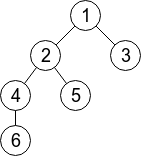CF771C:Bear and Tree Jumps(树形dp & 树上距离和)
来源:互联网 发布:变态的皇帝知乎 编辑:程序博客网 时间:2024/05/29 07:06
A tree is an undirected connected graph without cycles. The distance between two vertices is the number of edges in a simple path between them.
Limak is a little polar bear. He lives in a tree that consists of n vertices, numbered 1 through n.
Limak recently learned how to jump. He can jump from a vertex to any vertex within distance at most k.
For a pair of vertices (s, t) we define f(s, t) as the minimum number of jumps Limak needs to get from s to t. Your task is to find the sum of f(s, t) over all pairs of vertices (s, t) such that s < t.
The first line of the input contains two integers n and k (2 ≤ n ≤ 200 000, 1 ≤ k ≤ 5) — the number of vertices in the tree and the maximum allowed jump distance respectively.
The next n - 1 lines describe edges in the tree. The i-th of those lines contains two integers ai and bi (1 ≤ ai, bi ≤ n) — the indices on vertices connected with i-th edge.
It's guaranteed that the given edges form a tree.
Print one integer, denoting the sum of f(s, t) over all pairs of vertices (s, t) such that s < t.
6 21 21 32 42 54 6
20
13 31 23 24 25 23 610 66 76 135 85 99 1111 12
114
3 52 13 1
3
In the first sample, the given tree has 6 vertices and it's displayed on the drawing below. Limak can jump to any vertex within distance at most 2. For example, from the vertex 5 he can jump to any of vertices: 1, 2 and 4 (well, he can also jump to the vertex 5 itself).

There are  pairs of vertices (s, t) such that s < t. For 5 of those pairs Limak would need two jumps: (1, 6), (3, 4), (3, 5), (3, 6), (5, 6). For other 10 pairs one jump is enough. So, the answer is 5·2 + 10·1 = 20.
pairs of vertices (s, t) such that s < t. For 5 of those pairs Limak would need two jumps: (1, 6), (3, 4), (3, 5), (3, 6), (5, 6). For other 10 pairs one jump is enough. So, the answer is 5·2 + 10·1 = 20.
In the third sample, Limak can jump between every two vertices directly. There are 3 pairs of vertices (s < t), so the answer is 3·1 = 3.
思路:树形dp,dp[i][j]表示i点到根节点的距离%k=j的节点数,这里的i是由底往上递归,所有节点的距离之和+所有节点差多少能被k整除的和,再除以k就是答案。
# include <bits/stdc++.h>using namespace std;typedef long long LL;const int maxn = 2e5+30;vector<int>v[maxn];int n, k;LL ans = 0, dp[maxn][5],h[maxn];void dfs(int cur, int pre, int d){ h[cur] = 1; dp[cur][d%k] = 1; for(auto to :v[cur]) { if(to == pre) continue; dfs(to, cur, d+1); for(int i=0; i<k; ++i) { for(int j=0; j<k; ++j) { int x = (i+j-d*2)%k;//经过以cur为根节点的两点LCA。 int y = (k-x)%k;//差多少才能被k整除。 ans += y*dp[cur][i]*dp[to][j]; } } for(int i=0; i<k; ++i) dp[cur][i] += dp[to][i]; ans += (n-h[to])*h[to];//计算树的两两距离(相当于累加这些边的贡献次数)。 h[cur] += h[to]; }}int main(){ int a, b; scanf("%d%d",&n,&k); for(int i=1; i<n; ++i) { scanf("%d%d",&a,&b); v[a].push_back(b); v[b].push_back(a); } dfs(1,0,0); printf("%lld\n",ans/k); return 0;}- CF771C:Bear and Tree Jumps(树形dp & 树上距离和)
- CF Bear and Tree Jumps树形DP
- Codeforces790B Bear and Tree Jumps -- 树形DP
- codeforces 711C. Bear and Tree Jumps(树上距离)
- codeforces 405 D. Bear and Tree Jumps 树形dp
- Codeforces 791D Bear And Tree Jumps 树形DP
- Codeforces Round #405 D. Bear and Tree Jumps 树形DP
- Codeforces790B. Bear and Tree Jumps 【树型DP】
- Codeforces 711C. Bear and Tree Jumps【树形dp好题】
- CF791D-Bear and Tree Jumps
- codeforces D. Bear and Tree Jumps
- codeforces 791D Bear and Tree Jumps
- 791D Bear and Tree Jumps
- Codeforces Round #405 Div. 1 B. Bear and Tree Jumps
- hdu5416 CRB and Tree(树形DP)
- E. Ostap and Tree(树形dp)
- HDU2376Average distance(树形dp|树上任意两点距离和的平均值)
- hdu2196Computer 经典树形dp 在树上求最长距离
- VS2015(Install Shield 2015 limited Edition )软件打包过程
- Android系统权限和root权限
- 【POJ 2236】Wireless NetWork(并查集应用)
- Linux中查找指定大小或者指定内容的文件
- Java线程 ,线程同步详解,单例
- CF771C:Bear and Tree Jumps(树形dp & 树上距离和)
- Hibernate
- RPC功能的实现
- java杨辉三角代码编写
- N皇后问题
- plsql develop 连接远程数据库
- Hive分区表操作
- 谈谈RunLoop
- Codeforces Round #426 (Div. 2)The Meaningless Game【数学题】【水题】


